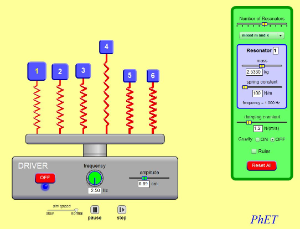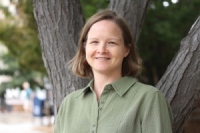|
|||||||||||||||||||
|
|||||||||||||||||||
|
Your donation brings science to kids in your town and around the world. So please consider:
All donations are tax deductible. Thanks for your support! Upcoming Events:AAPT Winter Meeting
ACS
2012 ISTE 2012 BCCE 2012 In the Pipeline:
Create a DVD Installation DiskDid you know you can install a local copy of PhET on your computer? And, we've improved our DVD installer to include the teaching activities along with the full suite of PhET sims. Ideal for computers that don't have internet access; all you need is a DVD writer, blank disks and an internet connection. More PhET PodCasts
|
Featured Sims:Build a Molecule
Learn about Resonance with Harmonic OscillatorsCheck Out These Other New Simuations:
Meet Our Director:Recently PhET director, Kathy Perkins, was featured on CU Connections. Here is an adaptation from her interview. For the full transcript, see http://connections.cu.edu/news/five-questions-for-kathy-perkins/
What are the main goals of PhET? PhET's mission is to advance science literacy and education worldwide through engaging, interactive simulations. Each simulation offers an intuitive, game-like environment where students can engage in exploration like a scientist would, and where they can see the invisible, so they can literally interact with things like electrons, neutrons and protons to build their own atoms. Through the interaction and the immediate feedback they get, they can develop an understanding of key science concepts such as important cause-and-effect relationships and can build connections to everyday life. They can also experiment with things they can't experiment with in everyday life, such as building molecules, changing gravity, or shooting photons. With the Circuit Construction Kit simulation, for instance, students can interact with a battery by easily increasing or decreasing the voltage with a slider and immediately see how a light bulb gets brighter and electrons go faster when they increase the voltage. With the simulations, students can develop a visual, mental model of what's happening.What makes PhET different from other simulations? One thing that makes the PhET project unique is that it's research-based. We take the published research and our own research, digest it, and integrate it into the design. Our group studies the features of effective simulations, how students learn from simulations, and use of simulations in the classroom. Right now, we have about 15 people on the PhET team. It's a great team. Everyone is vested in making the best simulations possible, simulations that are highly effective learning tools and are also fun for students. When we start a new simulation, we create a design team with expertise across different areas. The team will have content specialists, teachers who would use the simulation, design experts, an education researcher and professional software developer. We brainstorm about the simulation. We storyboard the design and develop scenarios of what students would be able to interact with. Once that's done, we start programming and test features as we go along. For every simulation, we conduct interviews with students. During the "think-aloud" interview, we ask them to open and play with everything and talk about what they are doing. We want to see whether students engage with learning from the simulation and find out what is working and what is not. We always learn something, and make revisions as necessary. It takes about four to nine months to complete a simulation.Where does PhET funding come from? Most of the funding comes from federal grants and foundations. We want the PhET project to be sustainable for the long-term, however, so we're trying to increase the number of corporate and individual donations. Companies are allowed to use the simulations for free. Pearson, for instance, uses them in textbooks and in their online homework system. We're working to develop an NPR-like model where companies sponsor the project in lieu of a licensing fee, so that we can create more simulations and improve the sustainability of the project. We are also trying to develop a micro-donation model so that individuals can donate small amounts. Every year, 22 million simulations are run from our website and in 5 years we expect this number to be more than 100 million. Eventually, micro-donations could help fund a significant fraction of the budget.This interview was conducted by Cynthia Pasquale for CU connections, where it originally appeared and from which it is reused with permission Don't forget to join us on Facebook, Twitter and our Blog!Be the first to learn about new sims, new teacher activities, articles and newsletters. We'd also love to hear how you use PhET in your classrooms. Spread the word so PhET can go viral.... |
||||||||||||||||||
|
You received this e-mail because you signed up at our website or emailed us at phethelp@colorado.edu. To opt out of these newsletters, please click on this link: @UNSUBSCRIBE@ or copy and paste the text into your browser. PhET Interactive Simulations | University of Colorado 390 UCB | Boulder, CO 80309-0390 |
|||||||||||||||||||









